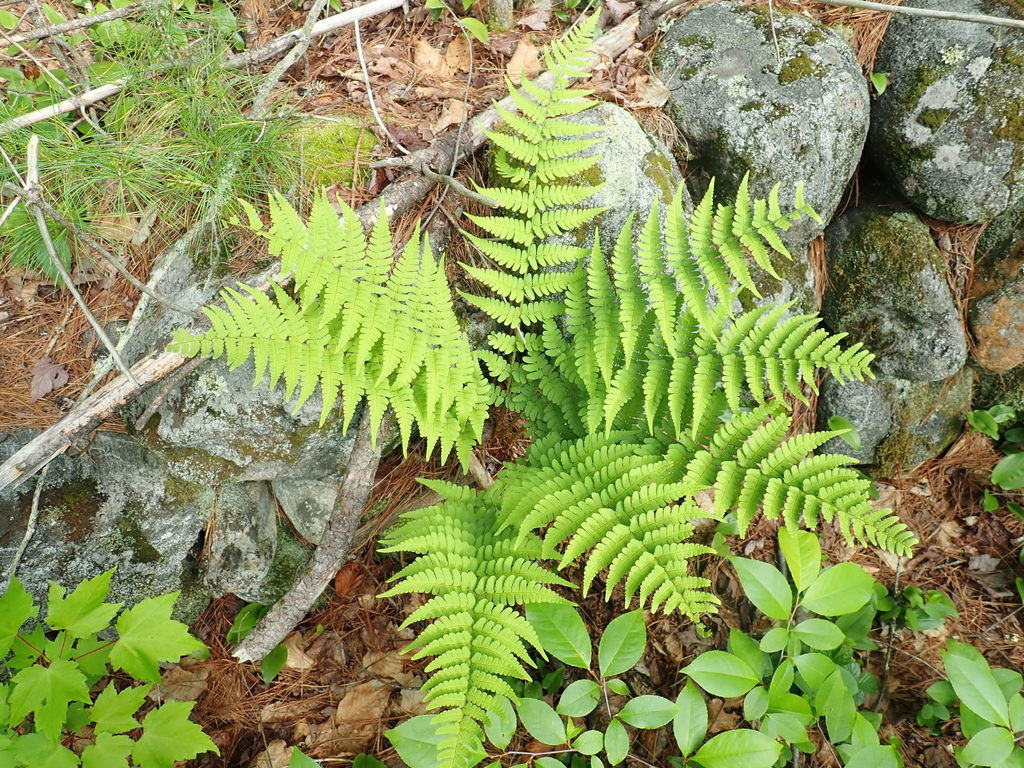Eloise Butler, co-founder in 1907 of the United States’ oldest public wildflower garden, praised marginal woodfern for "doing duty the whole year round." The vase-shaped fern’s leathery, blue-green fronds decorate the winter landscape until new fronds mature in spring, giving it another common name of evergreen woodfern. Marginal woodfern’s erect, airy form typically grows 2 feet tall and nearly as wide. It grows non aggressively with a distinct, individual habit in shady areas of woodlands with rich, moist soils. As the most drought tolerant of the woodferns, it may be a good plant for drier areas with dappled light or full shade. Like other ferns, the tough and highly textured leaves are not overly appealing to deer or rabbits.
The year-long show begins in late winter, when tightly curled, golden-brown fiddleheads (croziers) emerge on yellowish stems (stipes and rachises) that arise from an upright rhizome. The fiddleheads mature into broad, lance-shaped fronds with blunted leaflets (pinnae) and long, golden-brown stipes. Ferns are vascular plants, characterized by having neither seeds nor flowers. They reproduce via spores, which are housed in spore cases called “sori.” As its common name suggests, this fern’s sori are located along the underside margins of the pinnae. They’re covered by umbrella-like shields (another common name is marginal shield fern) called “indusia,” which protect the sori and their spores. The sori pop open when air moisture is low, releasing dust-like spores into the air. The genus name comes from the Greek word drys, meaning “tree,” and pteris, meaning “fern.” Sources say this could refer to the small, trunk-like rhizome or to the deciduous woodlands in which the ferns often grow. Accordingly, oak leaves are often recommended as a winter mulch.
Native habitats include moist woods and ravines and shaded crevices of rocky ledges and bluffs. Use as a specimen or in groupings in shady areas of the woods and in rock, native, winter, or shade gardens. Mixes well with spring wildflowers.
Plant Characteristics:
Grows 1-3’ tall and 2-3’ wide.
Prefers part or full shade.
Prefers moist, rocky, acidic, humus-rich soils but adapts to drier soils and clay or loam with good drainage. Tolerates lime.
Compound, twice-pinnate fronds are 15-20" long, broader in the middle and rapidly tapering to a point. Evergreen color is bluish green above and yellowish green underneath. Lance-shaped, smooth-edged pinnae with blunt tips occur in pairs of 15-20. Rounded sori mature from green to dark brown and are covered with a kidney-shaped indusium.
The grooved stipe is swollen at its reddish base and is 1/4 to 1/3 the length of the frond.
Wildlife Value:
Host plant for larvae of specialist marsh fern and ghostly fern moths. The plant provides year-round cover near the ground for toads and lizards, and songbirds use its parts for nest construction. Deer seldom browse on ferns.
Medicinal, Edible, and Other Uses:
The fronds have been used as a hair rinse, but they may cause skin irritation.
Warning: All parts are toxic and should not be consumed.
top of page
$8.00Price
Excluding Sales Tax
Out of Stock
bottom of page

